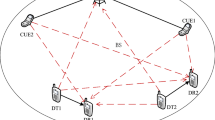Abstract
In the formulating of power control for wireless networks, the radio channel is commonly formulated using static models of optimization or game theory. In these models, the optimization programming or static game is played from time point to time point. Therefore, this approach neglects the dynamics of the time-varying channels and assumes the statistical independence between the successive time points. In this paper, we utilize differential equations to model the wireless links, then formulate a differential game for the power control problem in device-to-device (D2D) communications underlaying cellular networks. The game players are the D2D pairs, which manage their transmit power by solving the continuous-time optimal control problems. The time-dependant cost function allows us to optimize the long-term expected cost, instead of point-wise instantaneous cost. We formulate the problem in an affine quadratic form that admits analytical solutions. The unique feedback Nash equilibrium of the game is shown to exist. From a stochastic optimal control algorithm, we design a distributed power control mechanism that converges to the game’s equilibrium. The simulation results show that the proposed approach achieves significant performance improvement compared to the point-wise based approaches.






Similar content being viewed by others
References
Huang, M., Caines, P. E., & Malhamé, R. P. (2004). Uplink power adjustment in wireless communication systems: A stochastic control analysis. IEEE Transactions on Automatic Control, 49(10), 1693–1708.
Charalambous, C. D., Djouadi, S. M., & Denic, S. Z. (2005). Stochastic power control for wireless networks via sdes: Probabilistic QoS measures. IEEE Transactions on Information Theory, 51(12), 4396–4401.
Holliday, T., Goldsmith, A., Glynn, P., & Bambos, N. (2004). Distributed power and admission control for time varying wireless networks. In IEEE global telecommunications conference, 2004 (GLOBECOM’04) (Vol. 2, pp. 768–774).
Chamberland, J. F., & Veeravalli, V. V. (2003). Decentralized dynamic power control for cellular CDMA systems. IEEE Transactions on Wireless Communications, 2(3), 549–559.
Mériaux, F., Lasaulce, S., & Tembine, H. (2013). Stochastic differential games and energy-efficient power control. Dynamic Games and Applications, 3(1), 3–23.
Lee, N., Lin, X., Andrews, J. G., & Heath, R. W. (2015). Power control for D2D underlaid cellular networks: Modeling, algorithms, and analysis. IEEE Journal on Selected Areas in Communications, 33(1), 1–13.
Ren, Y., Liu, F., Liu, Z., Wang, C., & Ji, Y. (2015). Power control in D2D-based vehicular communication networks. IEEE Transactions on Vehicular Technology, 64(12), 5547–5562.
Yanfang, X., Yin, R., Han, T., & Guanding, Y. (2014). Dynamic resource allocation for device-to-device communication underlaying cellular networks. International Journal of Communication Systems, 27(10), 2408–2425.
Meshkati, F., Chiang, M., Poor, H. V., & Schwartz, S. C. (2006). A game-theoretic approach to energy-efficient power control in multicarrier CDMA systems. IEEE Journal on Selected Areas in Communications, 24(6), 1115–1129.
Wang, X., Zheng, W., Zhaoming, L., Wen, X., & Li, W. (2016). Dense femtocell networks power self-optimization: An exact potential game approach. International Journal of Communication Systems, 29(1), 16–32. IJCS-13-0930.R1.
Buzzi, S., & Saturnino, D. (2011). A game-theoretic approach to energy-efficient power control and receiver design in cognitive CDMA wireless networks. IEEE Journal of Selected Topics in Signal Processing, 5(1), 137–150.
Chen, X., Hu, R. Q., & Qian, Y. (2014). Distributed resource and power allocation for device-to-device communications underlaying cellular network. In 2014 IEEE global communications conference (pp. 4947–4952).
Le Treust, M., & Lasaulce, S. (2010). A repeated game formulation of energy-efficient decentralized power control. IEEE Transactions on Wireless Communications, 9(9), 2860–2869.
Thuc, T. K., Hossain, E., & Tabassum, H. (2015). Downlink power control in two-tier cellular networks with energy-harvesting small cells as stochastic games. IEEE Transactions on Communications, 63(12), 5267–5282.
Semasinghe, P., & Hossain, E. (2015). Downlink power control in self-organizing dense small cells underlaying macrocells: A mean field game. IEEE Transactions on Mobile Computing, 15(2), 350–363.
Huang, M., Caines, P. E., & Malhamé, R. P. (2007). Large-population cost-coupled LQG problems with nonuniform agents: Individual-mass behavior and decentralized \(\varepsilon\)-Nash equilibria. IEEE Transactions on Automatic Control, 52(9), 1560–1571.
Charalambous, C. D., & Menemenlis, N. (1999). Stochastic models for long-term multipath fading channels and their statistical properties. In Proceedings of the 38th IEEE conference on decision and control, 1999 (Vol. 5, pp. 4947–4952). IEEE.
Nocedal, J., & Wright, S. (2006). Numerical optimization. Berlin: Springer.
Song, L., Niyato, D., Han, Z., & Hossain, E. (2015). Wireless device-to-device communications and networks. Cambridge: Cambridge University Press.
Basar, T., & Olsder, G. J. (1999). Dynamic noncooperative game theory (2nd edn.). Classics in applied mathematics. Society for Industrial and Applied Mathematics.
Han, Z. (2012). Game theory in wireless and communication networks: Theory, models, and applications. Cambridge: Cambridge University Press.
Song, H., Jong Yeol, R., Choi, W., & Schober, R. (2015). Joint power and rate control for device-to-device communications in cellular systems. IEEE Transactions on Wireless Communications, 14(10), 5750–5762.
Chiang, M., Hande, P., Lan, T., & Tan, C. W. (2008). Power control in wireless cellular networks. Foundations and Trends® in Networking, 2(4), 381–533.
Acknowledgements
This work was supported by the National Research Foundation of Korea (NRF) grant funded by the Korea Government (MEST) (No. NRF-2016R1A2B1013733).
Author information
Authors and Affiliations
Corresponding author
Additional information
Publisher's Note
Springer Nature remains neutral with regard to jurisdictional claims in published maps and institutional affiliations.
Rights and permissions
About this article
Cite this article
Thi, MT., Radwan, A., Huynh, T. et al. Differential Game for Distributed Power Control in Device-to-Device Communications Underlaying Cellular Networks. Wireless Pers Commun 109, 2289–2303 (2019). https://doi.org/10.1007/s11277-019-06682-7
Published:
Issue Date:
DOI: https://doi.org/10.1007/s11277-019-06682-7




